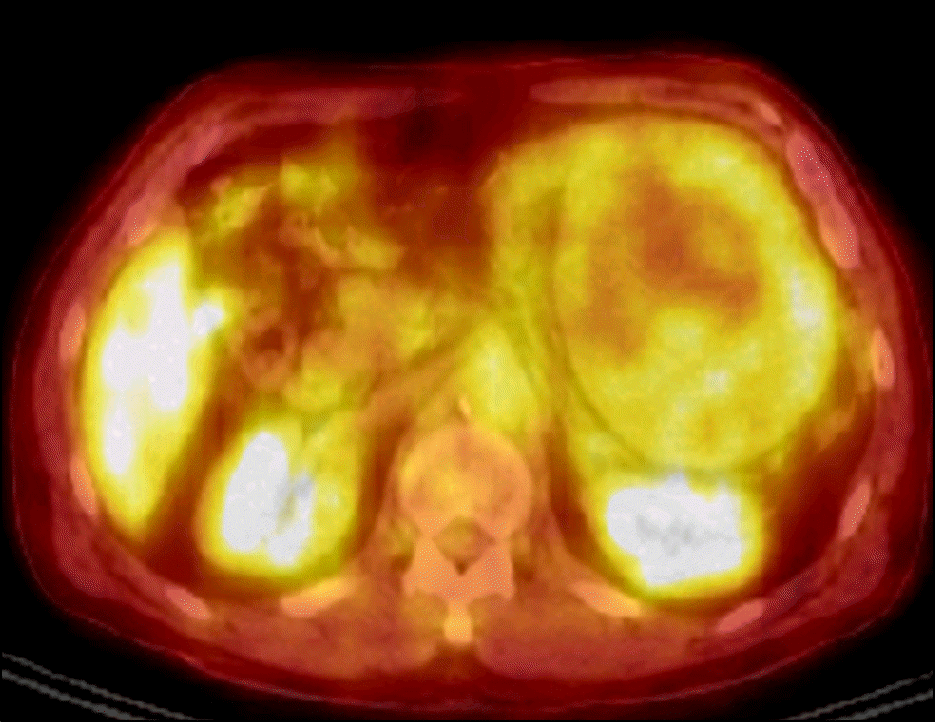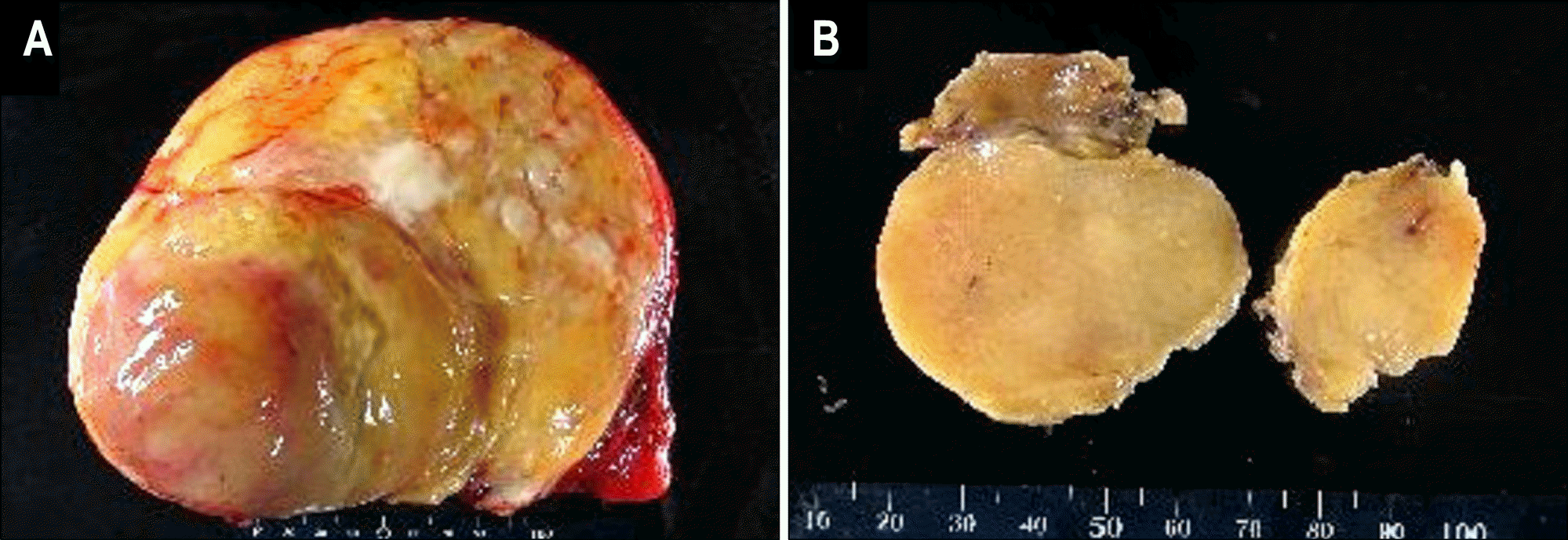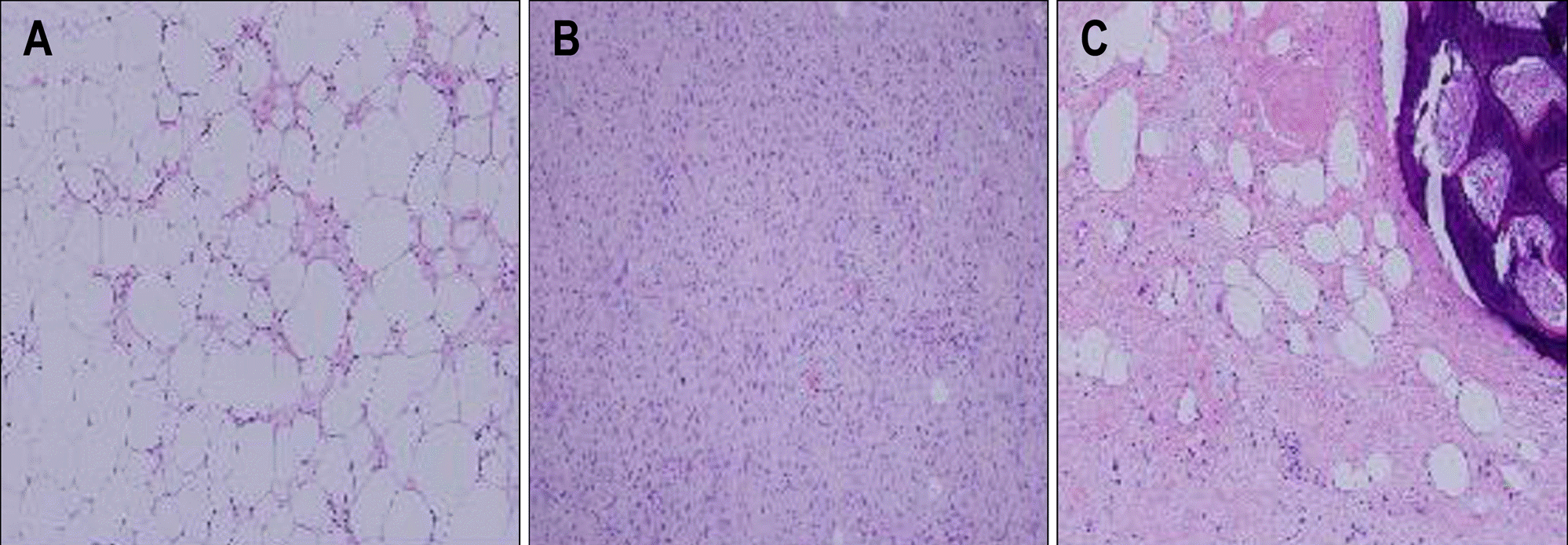Abstract
A liposarcoma is the most common soft tissue sarcoma in adults with an incidence of about 20% of all soft tissue sarcomas. Although incidence differs from a region of origination, a case arisen from mesentery has rarely been reported. We experienced a case of liposarcoma arising from the mesentery of a 51-year-old male patient. He was treated by wide excision. Histologically, the tumor was composed of a mixed well-differentiated liposarcoma with myxoid and spindle cell type.
Go to : 
REFERENCES
1. Russell WO, Cohen J, Enzinger FM, et al. A clinical and pathological staging system for soft sarcomas. Cancer. 1977; 40:1562–1570.
2. Lopez-Negrete L, Luyando L, Sala J, Lopez C, Menendez de Llano R, Gomez JL. Liposarcoma of the stomach. Abdominal Imaging. 1997; 22:373–375.
3. Takagi H, Kato K, Yamada E, Suchi T. Six recent liposarcomas including the largest to date. J Surg Oncol. 1984; 26:260–267.
4. Moyana TN. Primary mesenteric liposarcoma. Am J Gastroenterol. 1988; 83:89–92.
5. Devita VT, Hellman S, Rosenberg SA. Cancer: principle practice of oncology. 6th ed.Philadelphia: Lippincott Williams & Wilkins;2001.
6. Angelo P, Dei Tos MD. Liposarcoma: new entities and evolving concepts. Ann Diagn Pathol. 2000; 4:252–266.
7. Robbins SL, Cotran RS. Robbins and Cotran pathologic basis of disease. 7th ed.Philadelphia: Elsevier Saunders;2005.
8. Devita VT, Hellman S, Rosenberg SA. Cancer: principle practice of oncology. 7th ed.Philadelphia: Lippincott Williams & Wilkins;2005.
9. Sato T, Nishimura G, Nonomura A, Miwa K. Intraabdominal and retroperitoneal liposarcomas. Int Surg. 1999; 84:163–167.
10. Singer S, Antonescu CR, Riedel E, Brennan MF. Histologic subtype and margin of resection predict pattern of recurrence and survival for retroperitoneal liposarcoma. Ann Surg. 2003; 238:358–371.

11. Bautista N, Su W, Oconnell TX. Retroperitoneal soft-tissue sarcomas: prognosis and treatment of primary and recurrent disease. Am Surg. 2000; 66:832–836.
12. Reitan JB, Kaalhus O, Brennhovd IO, Sager EM, Stenwig AE, Talle K. Prognosis factors in liposarcoma. Cancer. 1985; 55:2482–2490.
13. Miettinen M, Sobin LH, Lasota J. Gastrointestinal stromal tumors of the stomach: a clincopathologic, immunohistochemical, and molecular genetic study of 1765 cases with longterm follow-up. Am J Surg Pathol. 2005; 29:52–68.
14. Chang HR, Hajdu SI, Collin C, Brennan MF. The prognostic value of histologic subtypes in primary extremity liposarcoma. Cancer. 1989; 64:1514–1520.

15. Enzinger FM, Winslow DJ. Liposarcoma. A study of 103 cases. Virchows Arch. 1962; 335:367–388.
Go to : 
 | Fig. 1.CT findings showed a large, heterogeneous, left-sided abdominal mass that did not extend across the midline into the right abdomen. The mass displaced the descending and transverse colon anteriorly and pushed most of the bowel into the right abdomen. |
 | Fig. 2.(A) Axial T2-weighted fast spin echo MR image showed a large tumor with heterogeneous high signal intensity and central intermediate signal intensity in left peritoneal cavity. (B) Coronal contrast-enhanced T1-weighted MR image showed heterogenous peripheral enhancement in the mass. |
 | Fig. 3.Integrated 18F-PET CT showed a FDG uptake in the peripheral portion of the mass (peak SUV=2.37) with central pho-topenic region. |
 | Fig. 4.Cut surfaces of the mesenteric masses. (A) The cut surface of the largest mass exhibited tan brown nodule in grey-yellow solid nodule. (B) The macroscopic findings of smaller masses resembled lipomas. |
 | Fig. 5.Microscopic findings of liposarcoma masses. (A) Two smaller masses consisted of many mature adipocytes and intervening few atypical spindle cells. (B) The central nodule of the largest mass demonstrated proliferation of stellate spindle cells and plexiform vasculature on rich myxoid stroma. (C) The peripheral portion of the largest mass contained areas of sclerosing variant with bony metaplasia (A & C: H-E, ×100; B: H-E, ×40). |




 PDF
PDF ePub
ePub Citation
Citation Print
Print


 XML Download
XML Download